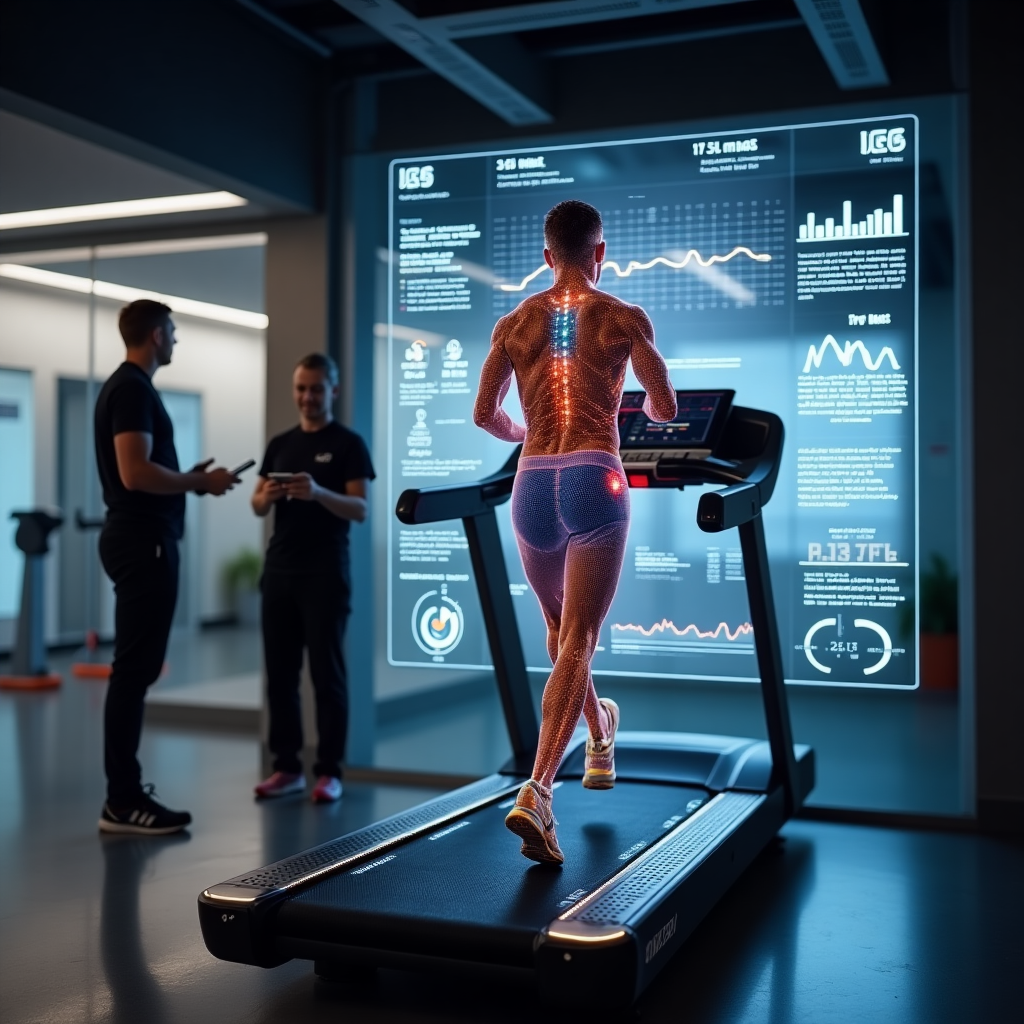Sports Technology Labs across the United States are revolutionizing how we understand athletic potential. Behind the success of many elite athletes lies a sophisticated network of data collection systems, biomechanical analysis tools, and predictive algorithms that can identify the tiniest opportunities for performance enhancement.
Advanced wearable assistive devices now capture thousands of data points per second during training sessions. Additionally, these labs employ disability innovation approaches that benefit athletes of all abilities, including those with prosthetics. The integration of tech for the disabled has led to breakthroughs in assistive wearables that monitor movement patterns with unprecedented precision.
This article takes you inside America’s cutting-edge sports labs where scientists and coaches collaborate to transform raw physical data into actionable insights. You’ll discover how motion capture, force plate analysis, and AI-powered systems work together to predict injury risk, optimize training loads, and ultimately forecast athletic success with remarkable accuracy.
How Sports Labs Use Data to Understand Movement
Modern athletic assessment fundamentally relies on quantifiable data to understand and enhance performance. Sports Technology Labs across the nation have established sophisticated methodologies that transform complex body movements into measurable metrics, ultimately revealing the biomechanical secrets behind elite athleticism.
Kinetics vs. Kinematics in Athletic Motion
At the core of movement analysis lies the distinction between two critical branches of biomechanics. Kinetics examines the forces that cause motion, such as muscular force and gravity 1. Conversely, kinematics quantifies the properties of movement, including velocity and acceleration, without considering the forces behind them 2. This differentiation allows scientists to build comprehensive profiles of athletic performance by analyzing both what moves and why it moves. While kinetics focuses on the relationships between forces acting on the body and their effects on motion, kinematics describes the geometric and time-based aspects of movement 2. This dual approach provides researchers with a complete picture of joint function, essential for optimizing performance and maintaining healthy joints.
3D Motion Capture and Force Plate Integration

The integration of 3D force plates with motion capture systems represents a technological breakthrough in sports science. These permanently installed plates measure ground reaction forces, torques, and center of pressure that occur when athletes stand, step, or jump 3. The data collected helps trainers improve performance and prevent injuries by recording balance and stability metrics 3. Advanced motion capture systems can detect differences in movements much smaller than can be seen by human observers, providing coaches and athletes with quantitative, objective feedback 4. High-speed cameras capture split-second movements while force plates embedded in floors record the forces acting at each foot and through the body 5. This combination allows for precise analysis of joint movements and loading during high-intensity activities.
Electromyography (EMG) for Muscle Activation
EMG technology adds another dimension to movement analysis by measuring electrical activity produced by skeletal muscles during contraction 6. This technique captures signals generated when muscle fibers depolarize and repolarize, offering insights into muscle activation patterns, timing, and intensity 7. The data helps optimize athletic performance and prevent injuries by revealing how muscles function during specific movements 8. Furthermore, EMG can monitor muscle fatigue through frequency analysis, as researchers have observed that median frequency decreases linearly over time as fatigue increases 6. By tracking changes in EMG activity patterns, coaches can identify when athletes approach excessive fatigue, indicating the need for rest or modified training protocols 8.
Inside the Lab: Tools That Power Performance Prediction

The cutting-edge tools within Sports Technology Labs form the backbone of athletic performance prediction systems. These sophisticated devices collect, analyze, and interpret data that human observers simply cannot detect, offering unprecedented insights into athletic potential.
Inertial Measurement Units (IMUs) in Wearables
IMUs represent a cornerstone technology in modern sports science, combining tiny gyroscopes, accelerometers, and magnetometers to track body movement with remarkable precision 9. These sensors capture critical metrics like acceleration, sprints, and deceleration patterns in real-time 9. Proper IMU placement significantly impacts data quality—although positioning near sport-specific body parts yields the most accurate readings, athlete comfort remains paramount for consistent usage 10.
Consequently, many professional teams now employ IMUs to track metrics ranging from sprinting speeds to jump heights, enabling coaches to assess techniques and create tailored training programs 9. Moreover, these devices measure body position, balance, and joint angles, providing crucial information for injury prevention 9. The data collected often transmits directly to smartphones and tablets, allowing immediate training adjustments based on real-time feedback 10.
High-Speed Cameras for Micro-Movement Analysis
High-speed cameras capture images at rates exceeding 1,000 frames per second, revealing movements invisible to the naked eye 11. This technology allows analysts to deconstruct complex athletic actions—baseball pitches, golf swings, or tennis serves—into their fundamental components 11.
For effective biomechanical analysis, cameras typically require at least 500 fps to properly analyze fast movements 12. Resolution also plays a critical role, with higher pixel counts providing richer data for micro-analyzing intricate movements 12. These systems often require approximately six times more lighting than standard video recording 12. Multiple synchronized cameras create comprehensive 3D images or track events from several angles, offering complete movement profiles for coaches and athletes 12.
AI Models Trained on Biomechanical Data
Artificial intelligence transforms raw biomechanical data into actionable insights through sophisticated modeling techniques. Machine learning algorithms process vast quantities of information, detecting patterns human analysts might miss 13. Neural networks and convolutional neural networks (CNNs) have become particularly valuable, with CNNs specializing in processing visual data for image recognition 14.
Recent research demonstrates how adding simulated data to measured inertial sensor datasets can significantly enhance prediction accuracy—reducing root mean square error for joint angles by up to 27% and moments by up to 6% 14. These AI systems analyze movement patterns in real-time, providing immediate feedback on biomechanical markers like stride length and ground contact time 13. This enables coaches to make instant adjustments to training programs, optimizing performance without delay 13.
From Data to Decisions: How Coaches and Scientists Collaborate
The collaboration between sports scientists and coaches represents the critical bridge that transforms raw data into actionable training strategies. This partnership enables immediate application of complex biomechanical insights for performance enhancement and injury prevention.
Real-Time Feedback Loops in Training
Biomechanical feedback systems enable coaches to make instant training adjustments based on objective performance data. These systems typically consist of four essential components: a user, sensors, a processing unit, and actuators that deliver feedback through visual, auditory, or haptic means 15. Timing proves crucial in these systems—humans can perceive latencies between 25ms (auditory/haptic) and 100ms (visual) without experiencing delays 15. Therefore, effective real-time feedback systems must operate within these constraints to feel natural to athletes. Studies demonstrate that providing feedback on every repetition can improve performance by 14%, compared to just 6% improvement without objective feedback 1.
Customizing Workload Based on Heart Rate Zones
Heart rate monitoring serves as a foundational tool for training customization, with several models offering different approaches to zone establishment:
- Lactate Threshold Model: Based on threshold heart rate, separating sustainable from unsustainable efforts 2
- Heart Rate Reserve Model: Uses two anchor points (max HR and resting HR) for personalized zones 2
- Max Heart Rate Model: Employs a single anchor point, useful for athletes new to training 2
Coaches can implement these models to design individualized training protocols that account for daily readiness fluctuations, subsequently reducing injury risk through appropriate workload management.
Injury Risk Modeling Using Joint Load Metrics
Predictive injury modeling has become increasingly sophisticated, incorporating variables like body composition, physical fitness tests, and biomechanical metrics. In football, studies have identified that sectorial position, body height, flexibility (sit-and-reach performance), upper body strength (push-ups), handgrip strength, and linear speed effectively predict injury risk 16. Indeed, research has shown that moderate-to-high impact intensity early in a basketball season, alongside increased cartilage synthesis biomarkers, correlates with higher injury rates in female players 17.
Velocity-Based Training in Weightlifting
Velocity-based training (VBT) enables precise resistance training prescription and monitoring through movement speed tracking. First, athletes must lift with maximal intent regardless of weight percentage 18. VBT allows coaches to set velocity targets or zones for specific training goals and autoregulate loads based on daily readiness 18. Furthermore, this approach facilitates fatigue management through velocity drop-off thresholds—when an athlete’s velocity decreases by a predetermined percentage (e.g., 30%), the set ends 18. Research confirms VBT’s effectiveness for improving performance while managing fatigue and preventing injuries 19.
The Future of Predictive Sports Science
Emerging technologies are rapidly reshaping how Sports Technology Labs predict athletic potential, with innovations expanding beyond elite environments to transform sports science at all levels.
Virtual Reality Treadmills for Simulated Testing

Advanced virtual reality treadmills now offer unprecedented testing capabilities in controlled laboratory settings. The C-Mill combines a traditional treadmill with augmented and virtual reality to create immersive training environments that objectively assess balance, gait, and adaptability 3. This technology enables athletes to safely practice competitive scenarios without physical risk while researchers collect precise movement data. Similarly, the Omni One system provides full 360-degree freedom, allowing users to walk, run, crouch, and jump naturally in virtual environments 20. These systems track steps, distance, and calories burned, creating detailed performance profiles 20. Studies demonstrate that VR-enhanced exercise results in higher satisfaction levels among participants compared to conventional training methods 21. In essence, these platforms allow athletes to practice decision-making and tactical awareness in environments that closely mimic real-world conditions.
Ethical Considerations in Athlete Data Ownership
As biometric tracking becomes more sophisticated, complex ethical questions have emerged regarding data ownership and privacy. Presently, biometric information collected from athletes often includes highly sensitive physiological and health data beyond basic statistics 22. In the U.S., data is typically owned by the company or team that acquires it, unlike in Canada and the EU where individuals maintain ownership of their personal biometric information 23. Policies must balance competitive advantages with athlete privacy rights through approaches like:
- Clear contractual agreements outlining data ownership and usage rights
- Data anonymization or pseudonymization protocols
- Restrictions on data sale to third parties 22
Collective bargaining agreements increasingly address these concerns, with organizations like the National Basketball Players Association negotiating provisions to ensure athletes retain specific rights over their personal biometric information 22.
Expanding Access to Amateur and Youth Athletes
The future of sports science includes democratizing access to advanced analytics technologies. A partnership between Fastbreak AI and adidas exemplifies this trend, providing over 6,000 athletes across the United States with access to premier athletic camps and tournaments 24. This initiative specifically addresses financial barriers, as approximately 43% of young athletes are currently priced out of participating in youth sports 24. Meanwhile, machine learning advancements promise to make sophisticated analytics more accessible for smaller organizations and lower-level competitions 6. Looking ahead, we can expect increasingly seamless integration of analytics into all aspects of sports operations, with greater emphasis on ethical considerations around data collection and privacy 6.
Conclusion
Sports Technology Labs across the United States stand at the forefront of athletic performance analysis, transforming how coaches identify and develop talent. These cutting-edge facilities combine sophisticated biomechanical tools with advanced data analytics to reveal insights previously invisible to the human eye. Accordingly, athletes now benefit from personalized training regimens based on objective measurements rather than subjective observations.
The integration of kinetic and kinematic analysis provides a comprehensive picture of athletic movement, while 3D motion capture systems detect micro-movements that escape visual detection. Additionally, EMG technology offers critical insights into muscle activation patterns, helping prevent injuries and optimize performance simultaneously. These technologies work together to create detailed profiles of each athlete’s unique biomechanical signature.
Wearable IMUs, high-speed cameras, and AI-powered analytical models have fundamentally changed how performance predictions occur. Though once limited to elite athletes, these technologies now extend their reach to amateur and youth sports programs. Therefore, talent identification no longer depends solely on a coach’s intuition but combines human expertise with data-driven insights.


[…] in technical support delivery. Forum discussions and reviews highlight recurring concerns with Comcast business tech […]